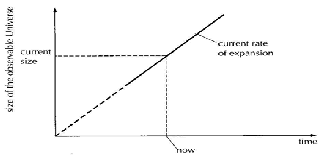The Future of the Universe
At the moment the Universe is expanding – that is, the observable Universe is expanding: we believe in fact that the Universe is infinite. At the moment the furthest objects that we can see is about 12 billion light tears away, and as a result of the Big Bang these distant objects are moving away from each other with speed proportional to distance. If there were no forces between the galaxies then they would continue to recede from each other at the same constant speed, so the size of the observable Universe would be proportional to time.


An open Universe is one that expands forever. Gravity slows down the rate of expansion but does not stop it. The density![]() of the Universe is not enough to stop the expansion.
of the Universe is not enough to stop the expansion.
An closed Universe is one that expands up to a maximum point and then starts to contract. Gravity slows down the rate of expansion and eventually stops it. The density![]() of the Universe is enough to stop the expansion.
of the Universe is enough to stop the expansion.
A flat Universe has a critical density![]() and is the borderline case between an open and closed Universe. Gravity slows down the rate of expansion but does not stop it. The density of the Universe is not enough to stop the expansion. You may think of the Universe taking an infinite time to reach a maximum size.
and is the borderline case between an open and closed Universe. Gravity slows down the rate of expansion but does not stop it. The density of the Universe is not enough to stop the expansion. You may think of the Universe taking an infinite time to reach a maximum size.